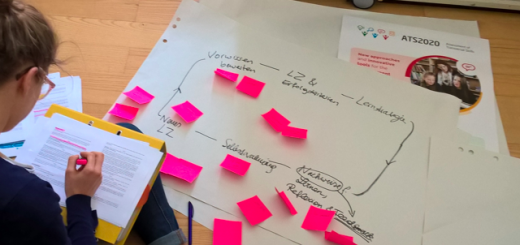Webinar “Learning Outcomes and Assessment”
Today I conducted a webinar for VALERU, dedicated to module 3 of the VALERU VNIL training. (I posted an article on how to design a webinar lately, too)
My participants consisted on future VNIL assessment experts, who go through a slightly different training with a focus on assessing reflective reports of VNIL training sessions (we also need people in the Russian Federation, speaking Russian, to mark/give feedback the reflective reports produced in training sessions in the RF also after the project’s lifetime).
All participants were already experienced in using learning outcomes. They reported that they usually use Bloom’s taxonomy. My webinar introduced Anderson’s and Krathwohl’s revised taxnomoy. It especially has a focus on verbs instead of nouns and the highest cognitive process is “to create” instead of “Evaluation”.
Here you can check out an interactive Flash-based model created by Iowa State University:
When you slide over the blocks of the taxonomy, you can discover appropriate learning outcomes.
We had interesting discussions, including:
- Threats of learning outcomes: Teaching/Learning to the test only, economisation of education, unified learning pathways instead of individual learning pathways if learning outcomes are defined in a too narrow
- Changing from an input (teacher-centred) to an output (student-centred) approach is difficult for teachers, who are used to teacher-centred methods. (learning mode “transfer” and “tutor” – not soo much learning mode “coach”, which is highly student-centred –> read more in the module 3 reader of the VALERU VNIL training)
- Lecturers in HE institutions often don’t see why they should change their practice – because for them the “old” way worked out fine too – but it isn’t appropriate anymore at the moment, HE needs to answer the student’s needs when it comes to individual, flexible learning pathways, developing autonomous learning skills, etc. – everything what makes a lifelong learner.
- Personal development and growth needs to be the maxime, which is leading us – also when it comes to learning outcomes!
Of course we also discussed the range of benefits deriving from the use of learning outcomes. Writing learning outcomes with the help of Bloom’s revised taxonomy indicates suitable teaching and assessing methods. Learning outcomes can support transparency for students, teachers and potential employees. They have a focus on the outcome – not how the learning process it taking place: You can learn at home, at work, at whatever time you want. It is just about the outcome of your learning process. All people are different and learn in different ways. Learning outcomes can provide openess, respecting all possible learning ways.
The discussion in the webinar were very interesting, so I am thinking to provide another webinar on the topic of learning outcomes, but next time open for everyone who would like to join!
Feel free to comment your thoughts on learning outcomes below! I’d love to have a good discussion.




1 Response
[…] webinar learning objectives are the main points of the webinar. They are as […]